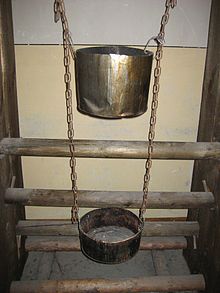Chinese water torture
This article includes a list of general references, but it lacks sufficient corresponding inline citations. (March 2010) |


Chinese water torture is a process in which water is slowly dripped onto a person's forehead, allegedly driving the restrained victim insane. This form of torture was first described under a different name by Hippolytus de Marsiliis in Italy in the 15th or 16th century.
Origin
The term "Chinese water torture" may have arisen from Chinese Water Torture Cell (a feat of escapology introduced in Berlin at Circus Busch September 13, 1910; the escape entailed Harry Houdini being bound and suspended upside-down in a locked glass and steel cabinet full to overflowing with water, from which he escaped), together with the Fu Manchu stories of Sax Rohmer that were popular in the 1930s (in which Fu Manchu subjected his victims to various ingenious tortures, such as the wired jacket). Hippolytus de Marsiliis is credited with the invention of a form of water torture. Having observed how drops of water falling one by one on a stone gradually created a hollow, he applied the method to the human body. Other suggestions say that the term "Chinese water torture" was invented merely to grant the method a sense of ominous mystery. The victim would be stripped of their clothes, shown to the public, then tortured. They would be driven insane while bystanders watched and mocked them.
The term "Spanish water torture" is also used in Europe, although this term often refers to a type of torture used during the Spanish Inquisition: Victims would be strapped down so that they could not move, and cold or warm water would then be dripped slowly on to a small area of their body; usually the forehead. The forehead was found to be the most suitable point for this form of torture because of its sensitivity: the victims could see each drop coming and, after a long duration of time, were gradually driven frantic as a perceived hollow would form in the center of their forehead.
